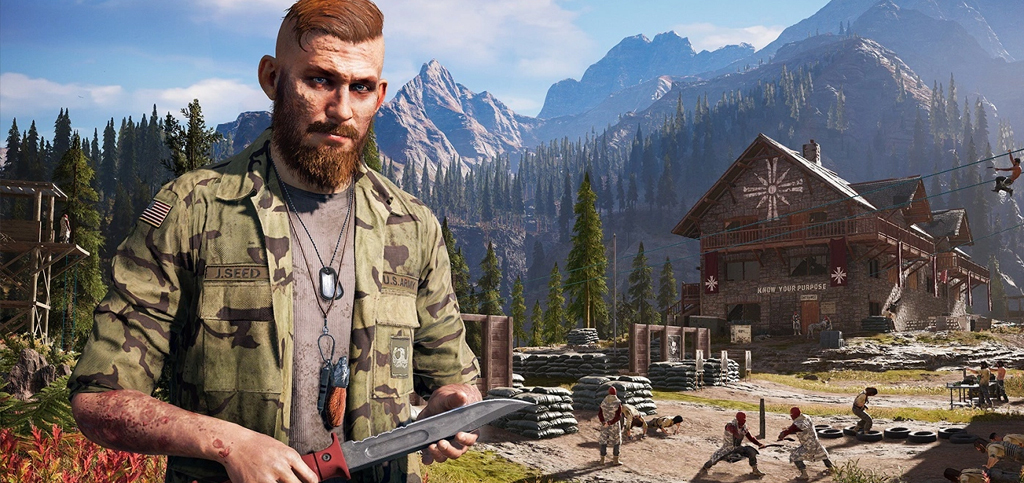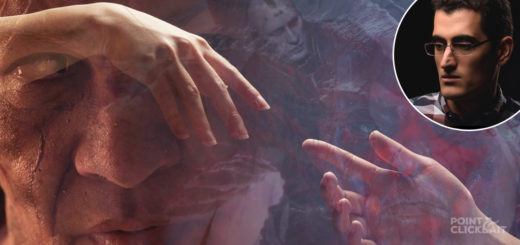Hands-On With Far Cry 5: A Radio Tower Bursting Out Of America’s Heart

In a first for the series, Far Cry 5 allows you to choose your name, your gender, and your skin colour. After playing with the sliders, I decided to explore the world of Far Cry 5 through a lens that rarely gets used in storytelling – that of a white man aged 18-35, with stubble and a frame just muscular enough to be masculine, but not so masculine as to be threatening.
The first character I meet is Hurk, fan favourite and returning character from Far Cry 3 and Far Cry 4. This time around Hurk is older and wiser, with more experience under his belt and a less happy go lucky attitude. I’m taken aback as a grim, one-eyed Hurk stares at me from a face ruined by scars and wearied by age.
“Aw, shucks,” says Hurk when I ask him whether he’s still poundin’ brews. “All that is behind me now. I’m here to do my part dealing with the deep malaise festering at the heart of the American Dream, bro.”
This party-loving funster goes on to say something about the necessity of a socialist revolution and how one side of politics is explicitly bad and the other side is correct, but I’ve stopped listening. I pound knuckles with this rockin’ bad boy and drive off to see what Hope Country has to offer.

Far Cry 5 eschews the dial-a-backup goon squad system of previous games, placing more emphasis on the ability to recruit and support the local every day people of Hope County. After saving local farmer Gerald Mason from an attack by Eden’s Gate cultists and a brown bear who charged over from 500 metres away after being clipped by a stray gunshot, he offers to join me in my fight.
I decide to let Gerald take charge and see what happens. He gets off to a rough start, T-posing several times and turning inside out. Eventually he seems to make up his mind, and drives our car to his farmhouse, where he carefully parks in the shadow of an old oak tree.
Curious, I follow Gerald around the farm as he goes about the daily life of a Montana farmer. We work together under the big sky for several months of in-game time, bringing in the cows, milking them, eating a home cooked meal, making love to our wife, putting our kids to sleep.
It’s an interesting direction for the series to take, and a great commentary on the decline of the American working class and the struggles faced by our local farmers in the age of Big Agriculture. It’s not for me, though – I’ve got radio towers to climb.
I wave goodbye to Gerald, who T-poses once more for old time’s sake and sinks through the floor, screaming. “He has returned to the soil that he loves so much,” explains Far Cry 5’s narrative director Jean-Sébastien Decant, who has silently appeared at my elbow.

I spend the next 30 minutes looking for a radio tower to climb, but I can’t find one. Decant coughs gently, and explains that the decision to remove radio towers was more a strategic choice than a design choice.
“When we signed onto the project, we fully expected to include radio towers like normal,” explained Decant. “Based on the success of other games, our natural inclination was to increase the number of radio towers.”
“Our first pass at the world map was littered with radio towers, dense and thick like the trees of a forest. But that was too much for players. Test audiences reacted strongly, recoiling, vomiting in some cases. Nasty business. We had to scale it back.”
Decant tells me that their new approach was to scale the radio towers down – so small that they become the size of atoms. “The secret,” he tells me, “ is that every single thing in the game, and maybe the world itself, is actually formed from microscopic radio towers.”
He reaches out and pulls a small object from behind my ear. It’s a tiny miniature radio tower.
“That’s incredible,” I whisper.
“No,” he says softly, placing the tiny radio tower into my hand and gently closing my fingers around it. “That’s Far Cry.”
Far Cry 5 is out later this month.























